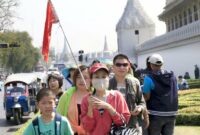Senior travel tour groups offer a unique opportunity for older adults to explore the world, connect with others, and create lasting memories. These tours cater to diverse interests and activity levels, from relaxing cruises to adventurous expeditions. Understanding the various types of groups, popular destinations, and essential planning considerations is key to a successful and enjoyable trip. This exploration delves into the multifaceted world of senior travel, addressing practical concerns and highlighting the enriching experiences available.
The variety of options available caters to different budgets and preferences, ensuring that there’s a perfect fit for every senior traveler. Whether it’s exploring historical landmarks, immersing oneself in different cultures, or simply relaxing on a beach, senior travel groups provide a structured and supportive environment for unforgettable adventures. We will examine the factors to consider when selecting a tour, including health and safety aspects, the role of technology in enhancing the experience, and effective marketing strategies employed by tour operators.
Types of Senior Travel Tour Groups
Choosing the right senior travel tour group depends heavily on individual preferences and physical capabilities. A wide variety of options cater to diverse interests and activity levels, ensuring a fulfilling and enjoyable experience for all. Understanding these differences is key to selecting the perfect trip.
Activity Level Categorization of Senior Travel Tour Groups
Senior travel tours are broadly categorized based on their activity levels: active, moderate, and relaxed. Active tours involve a significant amount of physical exertion, moderate tours offer a balance between activity and relaxation, while relaxed tours prioritize comfort and minimal physical demands. This categorization helps travelers assess their suitability for a particular tour.
Examples of Niche Senior Travel Tour Groups
Beyond the general activity level classifications, numerous niche tours cater to specific interests. Adventure tours might involve hiking, kayaking, or wildlife safaris, demanding a higher level of physical fitness. Cultural immersion tours focus on exploring historical sites, attending local events, and engaging with the local culture, requiring moderate physical activity. Wellness retreats prioritize relaxation, rejuvenation, and self-care through activities like yoga, meditation, and spa treatments, requiring minimal physical exertion.
Demographics of Participants in Different Tour Group Types
Active tours tend to attract participants who are relatively fit and enjoy physically demanding activities. These individuals are often active in their daily lives and seek adventure. Moderate tours appeal to a broader demographic, including those who enjoy a mix of activity and relaxation. Participants in this category may have some limitations but still enjoy exploring new places. Relaxed tours typically attract individuals who prioritize comfort and convenience, potentially those with mobility limitations or who prefer a slower pace of travel.
Comparison Table of Senior Travel Tour Group Types
| Tour Type | Cost (Estimate) | Duration (Example) | Typical Activities |
|---|---|---|---|
| Active Adventure Tour (e.g., Hiking in the Alps) | $4,000 – $8,000+ | 10-14 days | Hiking, mountain biking, rock climbing (with appropriate skill levels and support) |
| Moderate Cultural Immersion Tour (e.g., Exploring historical sites in Italy) | $3,000 – $6,000 | 7-10 days | Guided tours of historical sites, museum visits, cooking classes, moderate walking |
| Relaxed Wellness Retreat (e.g., Yoga and Spa Retreat in Bali) | $2,500 – $5,000 | 5-7 days | Yoga classes, meditation sessions, spa treatments, leisurely walks, relaxation activities |
Destinations Popular with Senior Travelers
Choosing the right destination is crucial for a successful senior travel experience. Factors such as accessibility, climate, cultural attractions, and pace of life all play a significant role in determining the ideal location for older travelers. This section will explore popular destinations both internationally and domestically, highlighting their unique appeal and suitability for various mobility levels.
Top 5 International Destinations for Senior Travel Groups
Several factors contribute to the popularity of these destinations among senior travelers. These include generally good infrastructure, manageable climates, rich cultural experiences, and a reputation for safety and ease of navigation.
- Portugal: Portugal offers a blend of history, culture, and beautiful coastal scenery. The relatively mild climate is appealing year-round, and the country boasts excellent infrastructure, making it easy to navigate for seniors. The charming towns and villages, delicious cuisine, and affordable prices are additional draws.
- Italy: Italy’s rich history, stunning art, and delicious food attract many senior travelers. While some areas might be more challenging to navigate than others, many cities offer accessible options, and the slower pace of life in smaller towns can be relaxing and enjoyable.
- France: France, with its iconic landmarks, charming villages, and world-renowned cuisine, remains a popular choice. While some areas may be more challenging to navigate, cities like Paris offer excellent accessibility features in many areas. The country’s well-developed transportation system also makes it easier for seniors to get around.
- Costa Rica: This Central American country offers a unique blend of natural beauty, adventure, and relaxation. The warm climate is inviting, and the country’s commitment to eco-tourism provides many accessible activities suitable for seniors with varying mobility levels. Many resorts and lodges cater specifically to the needs of older travelers.
- Japan: Japan’s blend of modern amenities and ancient traditions, coupled with its efficient public transportation system, makes it a surprisingly accessible destination for seniors. The cleanliness, safety, and politeness of the Japanese culture add to the overall positive experience.
Domestic Travel Destinations Popular with Senior Groups within the United States
Domestic travel within the US offers convenience and familiarity, making it a popular choice for senior groups. Many destinations cater specifically to the needs of older travelers, offering accessible accommodations and activities.
- National Parks (e.g., Yellowstone, Grand Canyon): While some areas within National Parks may present accessibility challenges, many offer paved trails, accessible visitor centers, and shuttle services. The stunning natural beauty makes it a rewarding experience for those who can manage the terrain.
- Coastal Regions (e.g., Florida, California): Coastal regions offer a relaxed pace of life, pleasant weather, and numerous accessible attractions. Many hotels and resorts cater specifically to senior travelers, offering amenities such as accessible rooms, pools, and transportation.
- Historic Cities (e.g., Charleston, Savannah, Boston): Historic cities offer a wealth of cultural attractions, often with accessible options. Many museums and historical sites offer wheelchair rentals and accessible entrances. However, cobblestone streets and uneven pavements can pose challenges in some areas.
- Cruise Lines: Cruises offer a convenient and accessible way to see multiple destinations. Many cruise lines cater specifically to senior travelers, offering accessible cabins, onboard activities, and shore excursions.
Comparison of Destination Advantages and Disadvantages for Senior Travelers
The ideal destination depends heavily on individual needs and preferences. Some destinations excel in accessibility, while others offer a richer cultural experience but may present more physical challenges.
| Destination Type | Advantages | Disadvantages |
|---|---|---|
| Coastal Regions | Relaxing atmosphere, pleasant weather, often good accessibility | Can be crowded during peak season, may lack cultural diversity |
| Historic Cities | Rich cultural experiences, many historical sites | Can be crowded, cobblestone streets and uneven pavements may pose challenges |
| National Parks | Stunning natural beauty, opportunities for outdoor activities | Can be physically demanding, some areas may lack accessibility |
| Cruise Ships | Convenient, accessible, multiple destinations | Can be expensive, may feel confined |
Destinations Suitable for Various Levels of Mobility
Accessibility features vary greatly between destinations and even within a single location. Careful planning and research are crucial.
- High Mobility: National Parks (with careful trail selection), active walking tours in European cities.
- Moderate Mobility: Coastal resorts with accessible amenities, cities with good public transportation (e.g., many parts of Japan).
- Low Mobility: Cruise ships with accessible cabins and amenities, resorts with accessible rooms and facilities (e.g., many all-inclusive resorts in the Caribbean).
Essential Considerations for Senior Travel Planning
Planning a senior travel tour requires meticulous attention to detail to ensure a safe, enjoyable, and memorable experience. This section outlines key considerations to help you navigate the planning process effectively and address potential challenges proactively.
The Importance of Comprehensive Travel Insurance for Seniors
Travel insurance is paramount for senior travelers, offering crucial protection against unforeseen circumstances. Standard travel insurance policies often have limitations for older travelers, potentially excluding pre-existing conditions or offering reduced coverage. Therefore, securing a policy specifically designed for seniors is essential. Such policies typically offer broader coverage for medical emergencies, including evacuation and repatriation, which can be particularly vital for older individuals with potential health concerns. They may also include provisions for trip cancellations or interruptions due to medical reasons, offering financial protection against significant losses. Consider policies that include coverage for lost or stolen luggage, as well as 24/7 emergency assistance services. Comparing several senior-specific travel insurance providers is highly recommended to find the best coverage at a reasonable price.
Essential Documents and Preparations for Senior Group Travel
Thorough preparation is key to a smooth journey. A comprehensive checklist should include: valid passports and visas (with sufficient validity beyond the travel dates), copies of all travel documents (stored separately from originals), travel insurance details (including policy number and emergency contact information), flight and accommodation confirmations, itinerary details, emergency contact information for family and friends, a list of medications (with dosages and instructions), a copy of medical history and any relevant medical records, sufficient funds (in a combination of cash and credit cards), and any necessary mobility aids (such as walking sticks or wheelchairs). Additionally, it’s advisable to inform your bank and mobile phone provider of your travel plans to avoid any issues with transactions or connectivity.
Benefits and Considerations of Booking with a Specialized Senior Travel Agency
Utilizing a senior travel agency offers significant advantages. These agencies possess expertise in catering to the specific needs and preferences of older travelers. They can provide tailored itineraries that accommodate physical limitations, offer accessible accommodations, and incorporate appropriate pacing and rest periods. They often have established relationships with hotels and transportation providers, ensuring smooth logistics and potentially securing better rates. Furthermore, they can provide valuable assistance with visa applications, travel insurance, and other administrative tasks, reducing the burden on the traveler. However, it’s important to research and compare different agencies, reading reviews and checking their credentials before making a booking to ensure they are reputable and offer the services you require.
Step-by-Step Guide for Planning a Senior Travel Tour
Planning a senior travel tour involves a series of steps:
- Determine Destination and Travel Style: Consider the group’s preferences and physical capabilities. Choose a destination with accessible transportation and accommodations. Decide on the type of tour (e.g., escorted, independent).
- Set a Budget and Timeline: Establish a realistic budget encompassing flights, accommodation, activities, meals, and incidentals. Determine the desired travel dates and duration.
- Book Flights and Accommodations: Reserve flights and accommodations well in advance, especially during peak season. Consider booking through a travel agency for assistance and potential discounts.
- Plan Activities and Excursions: Research and book activities and excursions that align with the group’s interests and physical abilities. Ensure accessibility and appropriate pacing.
- Arrange Transportation: Plan transportation between the airport, hotel, and various activities. Consider using accessible transportation options.
- Finalize Travel Documents and Insurance: Gather all necessary travel documents and ensure comprehensive travel insurance is in place.
- Pack Appropriately: Pack comfortable and appropriate clothing and footwear, considering the climate and planned activities. Don’t forget essential medications and any necessary mobility aids.
- Inform Relevant Parties: Inform your bank, mobile phone provider, and family/friends of your travel plans.
Health and Safety Aspects of Senior Group Travel
Prioritizing the health and safety of senior travelers is paramount for any successful tour operation. Reputable tour operators implement comprehensive measures to mitigate risks and ensure a worry-free experience for their clients. This involves a multifaceted approach encompassing pre-trip planning, on-site support, and emergency preparedness.
Tour Operator Safety Measures
Tour operators dedicated to senior travel often employ experienced and trained staff who are equipped to handle various situations. These measures may include 24/7 emergency contact availability, readily accessible first-aid kits, pre-arranged medical assistance networks in destination locations, and detailed itineraries that consider the physical capabilities of participants. Many operators also incorporate regular check-ins with group members to monitor well-being and address any concerns promptly. For example, a tour might schedule frequent rest stops during long journeys or provide options for less strenuous activities for those who need it. Furthermore, operators often partner with local medical facilities to ensure swift access to healthcare in case of emergencies.
Tour Selection for Diverse Health Needs
Choosing a tour that caters to individual health conditions and mobility levels is crucial for a positive travel experience. Many tour operators offer specialized trips designed for seniors with specific needs. For instance, tours focusing on gentle walking or wheelchair-accessible destinations are becoming increasingly common. Travelers should carefully review tour itineraries, paying close attention to activity levels, transportation methods, and accommodation accessibility. Detailed descriptions of daily activities, including distances walked and terrain types, are vital pieces of information to consider when choosing a suitable tour. Some tours might emphasize relaxation and cultural immersion over physically demanding activities, providing a more comfortable pace for seniors with limited mobility.
Pre-Trip Medical Consultations and Vaccinations
A pre-trip medical consultation is highly recommended for all senior travelers, especially those with pre-existing health conditions. This consultation allows for a comprehensive review of the traveler’s health status, medication requirements, and necessary vaccinations. The physician can provide guidance on managing any health concerns during travel, such as packing sufficient medication, understanding local healthcare systems, and identifying potential health risks associated with the destination. Depending on the destination, certain vaccinations might be required or recommended to prevent infectious diseases. For example, a trip to a tropical region might necessitate vaccinations against yellow fever or typhoid. This proactive approach helps to minimize potential health complications during the trip.
Communicating with Healthcare Providers Internationally
Effective communication with healthcare providers while traveling internationally is essential. Senior travelers should carry a comprehensive medical history, including a list of medications, allergies, and any relevant medical conditions, in both their native language and English. It is also helpful to have a translated copy of any essential medical documents. In the event of a medical emergency, having a designated contact person who can communicate effectively with local healthcare providers can significantly expedite the process of obtaining appropriate medical care. Consider carrying an international medical assistance card or travel insurance information for quick reference. Knowing the local emergency numbers and having a translation app on your phone can also prove beneficial in such situations.
End of Discussion
Planning a senior travel tour requires careful consideration of various factors, from choosing the right type of tour and destination to ensuring health and safety. By understanding the different options available, leveraging technology to enhance the experience, and utilizing effective planning strategies, seniors can embark on enriching and memorable journeys. The focus should always be on creating a comfortable, safe, and fulfilling travel experience tailored to the specific needs and desires of the participants. Ultimately, senior travel tours provide an invaluable opportunity to experience new cultures, create lasting memories, and enjoy the golden years to the fullest.




